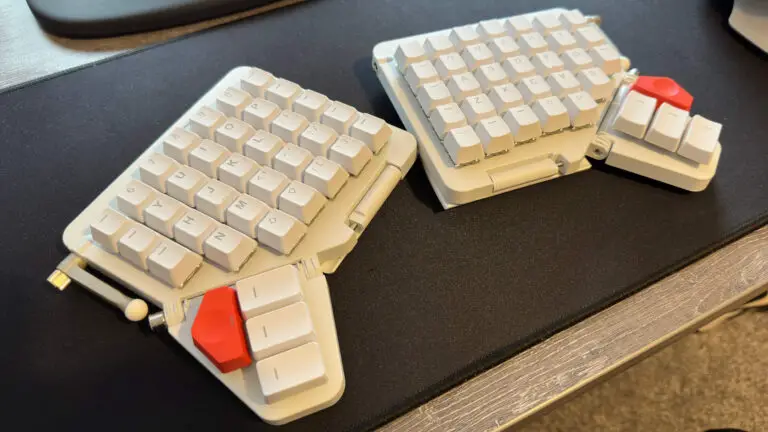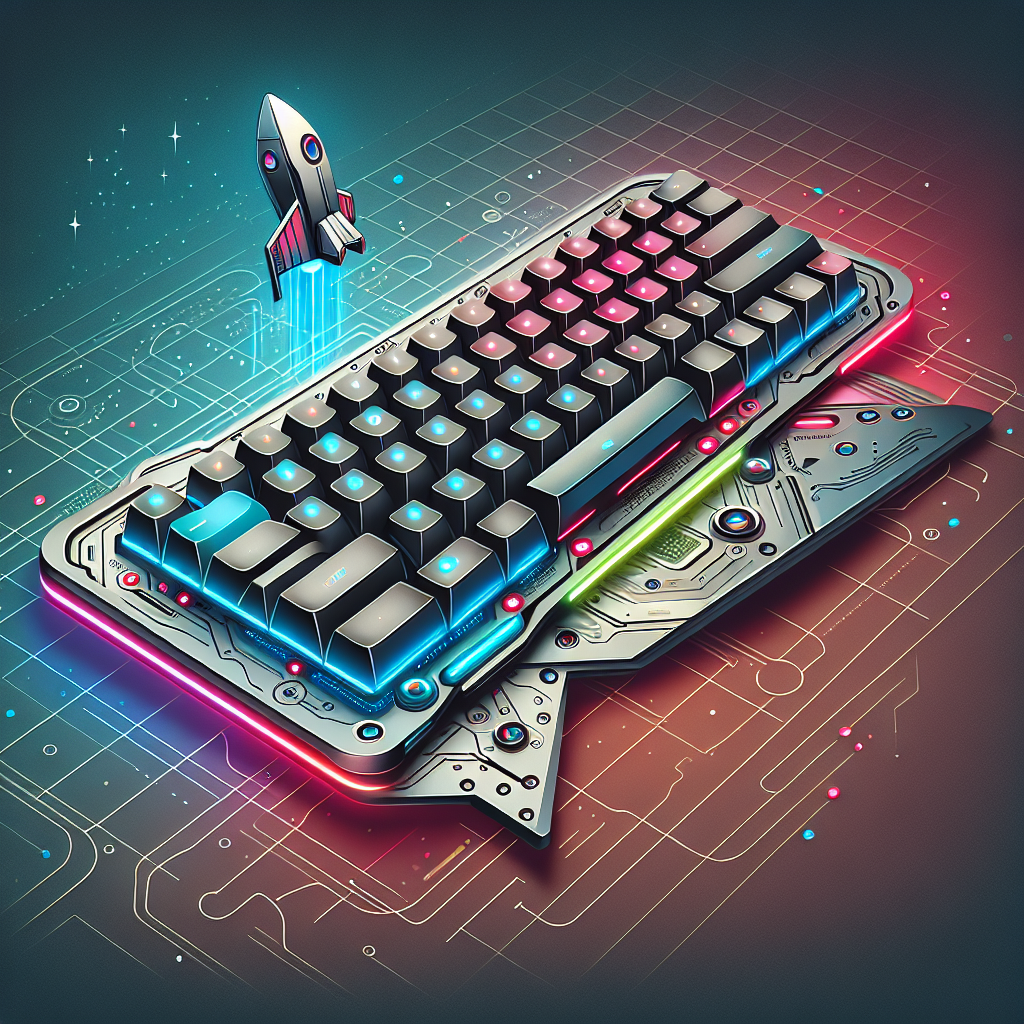Our Verdict
The ZSA Moonlander ergonomic keyboard is lauded for its space-age design, providing supreme comfort and ease of use. However, its high cost is a significant consideration for potential buyers. The keyboard’s ergonomic features are specifically designed to reduce strain and promote a natural hand position, which may justify the investment for those seeking the ultimate in comfort and ergonomics.

Pros and Cons
Pros
- Very comfortable in use
- Quick to setup
- Easy key remapping
- The app is extra handy
Cons
- Lengthy adaptation period
- Very expensive
- Blanks keys are confusing at first
- No wireless option
Product Overview
The ZSA Moonlander is an ergonomic keyboard that boasts a space-age design, aiming to provide a comfortable and natural typing experience. Released by Ontario-based ZSA Technology in 2020, it follows the company’s first ergonomic keyboard, the ErgoDox EZ, and features a similar split, columnar key arrangement.
The Moonlander’s design is sleeker and arguably more ergonomic than its predecessor. It aims to align with the natural resting position of your arms and hands on a desk, reducing shoulder rotation and wrist strain. The keyboard’s split design and tenting, which raises the inner regions, contribute to its ergonomic benefits, along with columnar keys that allow for vertical finger movement.
With 72 fully remappable keys, the Moonlander is designed to minimize finger movement. It includes four keys under each thumb, which can be customized for functions like Space, Enter, and Tab. The blank keys are intended for personal remapping, which can be initially confusing but allows for a highly personalized setup.

Specifications
| Switches | Cherry MX or Kailh (multiple options) |
| Connectivity | wired (USB Type-C) |
| Keys | 72 in total, fully remappable |
| Split | fully separate halves, wired connection |
| Tenting | continuously adjustable |
| Backlighting | per-key RGB |
| Media controls | shortcuts via alternate key mode |
| Price | $365 |
Setup and Software
Setting up the ZSA Moonlander is straightforward. Users simply need to connect the two halves of the keyboard with the supplied 3.5mm cable and insert the provided USB Type-C cable into the left section. While there is no wireless option, the simplicity of the setup is a plus.
The software side is equally user-friendly. The Moonlander can be configured using the Onyx page on ZSA’s website or through the Keymapp program, which is available for Windows, Linux, and MacOS. These tools allow users to view and customize what each key does, making the process of key remapping very accessible.
For those who require specific ergonomic adjustments, the tenting of the keyboard can be altered using a hex key included with the travel pouch. This customization helps users find the most comfortable typing angle, although the process can be a bit fiddly and may take some trial and error to get right.
Ergonomics and Adaptation
The ZSA Moonlander is designed with ergonomics at its core. The keyboard’s split design and tenting help to prevent shoulder rotation and reduce wrist strain. The columnar keys promote a more natural vertical movement for the fingers, aligning with the body’s natural resting position.
However, adapting to the Moonlander’s layout can take some time, especially for those accustomed to traditional keyboards. The transition requires a period of adjustment as users retrain their muscle memory to the new ergonomic layout. This period can be lengthy, but it is essential for reaping the ergonomic benefits of the keyboard.
Adjusting the tenting is a key part of the ergonomic setup, and while the Moonlander offers a continuously adjustable system, finding the right angle can be somewhat tricky. Users can customize the tenting to their liking using the included hex key, although a ratchet or notch system for uniform adjustment could simplify the process.
Gaming Experience
The ZSA Moonlander offers a unique gaming experience due to its ergonomic design. While it may take time for gamers to adapt to the split, columnar layout, the keyboard is capable of supporting gaming needs once accustomed to it.
However, the Moonlander’s design choices, such as the absence of a dedicated Left Control key, may require gamers to remap keys in-game or adjust the keyboard’s configuration to suit their preferences. This could be a hurdle for games that are less flexible with keybindings.
With 72 keys, the Moonlander has fewer keys than a standard keyboard, which means that many symbols and functions are accessible only through a ‘layer’ key that activates a new mapping. This layer system can be a limitation for those who rely on a full array of keys but can be adapted to over time.
Despite these considerations, the Moonlander can be a good fit for gamers looking for an ergonomic solution, provided they are willing to invest the time to customize and adapt to the keyboard’s unique layout.
Customization
The ZSA Moonlander shines in its customization options. Users can easily remap keys to their liking, which is facilitated by the keyboard’s blank keys designed for personalization. This feature allows for a highly individualized setup, accommodating various typing styles and preferences.
Switch replacement is another area where the Moonlander offers flexibility. The keyboard supports a range of Cherry MX or Kailh switches, giving users the freedom to choose their preferred tactile feedback and sound profile. The process of swapping out keycaps and switches is made simple with the included tool, further enhancing the keyboard’s adaptability.
ZSA’s build-to-order approach means that each keyboard can be tailored from the outset, with a comprehensive list of switch options available at the point of purchase. This level of customization ensures that the Moonlander can be fine-tuned to meet the specific needs of any user, whether for general typing or gaming.
Price and Value
The ZSA Moonlander is positioned at a premium price point of $365, which may be a significant investment for many potential users. The keyboard’s high cost is reflective of its specialized ergonomic design and the extensive customization it offers.
While the price may be steep, the value proposition lies in the Moonlander’s ability to provide a comfortable, stress-free typing experience that can be tailored to individual needs. For those who prioritize ergonomics and are willing to invest in their comfort and health, the Moonlander could be a worthwhile purchase.
However, it’s important to note that the Moonlander is not a one-size-fits-all solution. It’s a boutique keyboard that caters to a niche market, and its value is most appreciated by those who seek the specific benefits it offers. For users who do not require the advanced ergonomic features or customization, there may be more cost-effective alternatives available.
The ZSA Moonlander stands out as a high-quality ergonomic keyboard that could be a game-changer for the right user. Its design and build quality justify its price to an extent, offering a typing experience free from discomfort. The learning curve is steep, and it’s not a keyboard for everyone, but for those who value ergonomics and are willing to adapt, the Moonlander is a serious contender.
Support from ZSA is a strong point, with intuitive software and a comprehensive training package available to help users make the most of their investment. While it may lack some features like wireless connectivity and a full array of keys, the Moonlander’s focus on ergonomics sets it apart as a purpose-built tool for comfort and customization.

